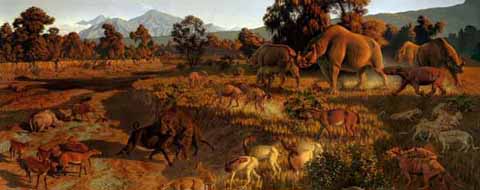
Oligocene community (Smithsonian Institution 2000)
A period
of extreme global cooling occurred at or near the Eocene-Oligocene boundary,
with glaciation accompanied by worldwide regression (Prothero 1998).
This cooling event strongly affected the southern hemisphere (Prothero
1998) and organisms living in high latitudes (WGBH 2001). Global
temperatures throughout the Oligocene were much cooler and had more seasonal
variation than those in the Eocene, and this caused a vegetation change
as the forests continued to decline and woodlands took their place (WGBH
2001). Because of the cooler, drier climate, grasslands
started to appear near the end of the epoch (WGBH 2001), but these did
not become widespread until the Miocene (Janis et al. 2002).
